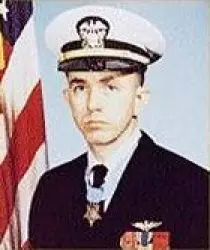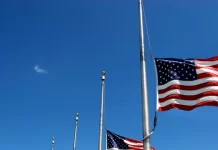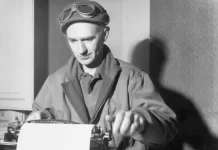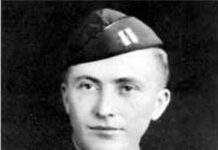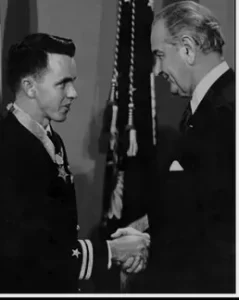While the Medal of Honor Society in South Carolina and the Naval Aviation Museum in Pensacola, Florida, differ on the precise number of Medal of Honor recipients who were naval aviators, both recognize Clyde E. Lassen as a Medal of Honor recipient, and the only Navy helicopter pilot to earn the Medal of Honor during the Vietnam War. The Naval Air Station Whiting Field dedicated its auditorium in the officer’s name in ceremonies held in January 2017.
The CDR Clyde E Lassen Auditorium serves as the location where every Navy, Coast Guard, and Marine Corps rotary wing aviator receives his gold wings designating each as a naval aviator It is the busiest air complex in the world, and produces more than 600 winged aviators every year.
This is the second building named for Cdr. Lassen during his lifetime. A flight training building that had been named for him previously was heavily damaged by Hurricane Ivan in 2004 and had to be bulldozed.
Born March 14, 1942, in Fort Myers, Florida, Lassen enlisted in the Navy in September 1961 and served four years, achieving the rate of Aviation Electronics Technician 3rd Class (AT3). He was then selected as a Naval Aviation Cadet and completed flight training at the Pensacola Naval Air Station, receiving his aviator wings and commissioned as an Ensign.
He was promoted to Lieutenant JG. and at the age of 26, was a helicopter pilot serving with the Search and Rescue team aboard the USS Preble, an Aegis guided destroyer He was on a mission to recover two downed Naval aviators who were in hiding after their plane had been shot down on a night mission deep inside North Vietnam. Lassen made several attempts but was not able to locate the pilots in the dense tree cover amid enemy weapon fire.
In a bold and brave move, Lassen turned on the helicopter’s landing lights, knowing it would reveal his position to the enemy, but also making himself visible to the downed pilots. The officers made their way to the helicopter now riddled with enemy fire, low on fuel., and managed to escape. Lassen headed to the sea and landed safely aboard the USS Jouett with less than five minutes of fuel remaining in the fuel line, completing a routine search and rescue mission safely.
President Lyndon Johnson presented the Medal of Honor to Lassen in ceremonies at the White House in January 1969.
Upon returning from Vietnam, Lassen continued to serve in the Navy, and served as Commanding Officer of Helicopter Training Squadron EIGHT (HT-8), an advanced rotary-wing training squadron for student aviators at Naval Air Station Whiting Field. He retired in 1982 with the rank of Commander and was a resident of Pensacola until his death from cancer in 1994.
He is buried at the Barrancas National Cemetery at Pensacola and his Medal of Honor is at the National Naval Air Museum there where the Auditorium named in his honor is located.
In addition to the Clyde Lassen Auditorium, the destroyer USS Lassen was commissioned and named in his honor and the SH-60 Seahawk was painted to commemorate his actions. The Florida Department of Veterans Affairs opened the Clyde Lassen Veterans’ Nursing Home in St. Augustine and the 120-bed facility offers skilled nursing care and accommodates residents with dementia/Alzheimer’s disease.
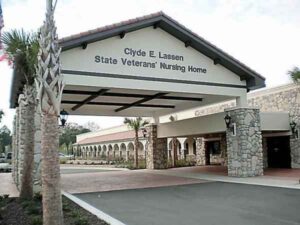
The Medal of Honor citation reads
For conspicuous gallantry and intrepidity at the risk of his life above and beyond the call of duty as pilot and aircraft commander of a search-and-rescue helicopter, attached to Helicopter Support Squadron 7, during operations against enemy forces in North Vietnam. Launched shortly after midnight to attempt the rescue of two downed aviators, Lt. (then Lt. (J.G) Lassen skillfully piloted his aircraft over unknown and hostile terrain to a steep, tree-covered hill on which the survivors had been located. Although enemy fire was being directed at the helicopter, he initially landed in a clear area near the base of the hill, but, due to the dense undergrowth, the survivors could not reach the helicopter. With the aid of flare illumination, Lt. Lassen successfully accomplished a hover between two trees at the survivors’ position. Illumination was abruptly lost as the last of the flares were expended, and the helicopter collided with a tree, commencing a sharp descent. Expertly righting his aircraft and maneuvering clear, Lt. Lassen remained in the area, determined to make another rescue attempt, and encouraged the downed aviators while awaiting resumption of flare illumination. After another unsuccessful, illuminated rescue attempt, and with his fuel dangerously low and his aircraft significantly damaged, he launched again and commenced another approach in the face of the continuing enemy opposition. When flare illumination was again lost, Lt. Lassen, fully aware of the dangers in clearly revealing his position to the enemy, turned on his landing lights and completed the landing. On this attempt, the survivors were able to make their way to the helicopter. En route to the coast he encountered and successfully evaded additional hostile antiaircraft fire and, with fuel for only five minutes of flight
